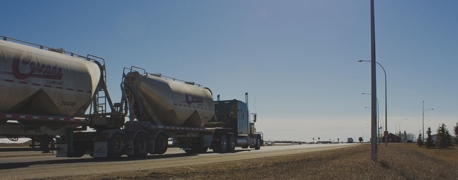Autonomous Trucking: Impact, Benefits & Risks

The prospect of an autonomous trucking industry is rapidly approaching as companies develop and test self-driving 18-wheelers on open highways. Autonomous trucks have the potential to revolutionize transportation and logistics by reducing costs, improving safety, and increasing efficiency. The idea is plausible: different levels of autonomy can be achieved through monitoring and remote control from a nearby manned station or control center or through artificial intelligence (AI) and machine learning that allow autonomous vehicles to make decisions independently.
However, serious obstacles block the path to making driverless trucking a reality. The obvious obstacles are technological: 'teaching' a machine to navigate a three-car pileup or a busy city street is still a long way off. Other obstacles are economic and political, with some truckers fearing unemployment and smaller carriers afraid they'll be left behind. The steepest obstacles might be social—will the public be willing to drive alongside 80,000 machines traveling at 55 mph with no human being behind the wheel?
In this article, we will explore the impact of autonomous trucking technology, with its benefits as well as its potential risks.
What Is an Automated Truck?
The phrase "automated truck" typically refers to a self-driving tractor-trailer that can navigate without human intervention. To date, there are no fully autonomous 18-wheelers; any self-driving tests are conducted with a human observer to intervene when necessary. However, autonomy isn't binary—it's measured in degrees, with autonomous trucks capable of varying levels of automation. At each level, autonomous trucks become more able to safely navigate the roads without human assistance.
Different companies are at different stages of development, but autonomous vehicles are already being tested in some places and used for limited purposes like long-distance highway hauls. What separates most vehicles from high-level autonomous systems is the source of monitoring; most cars have required a human driver to monitor the environment. Level 3 or higher autonomous vehicles monitor the environment via an array of sensors.
The six degrees of vehicle automation (established by the Society of Automotive Engineers) include the following:
- Level 0: Human controls all driving functions.
- Level 1: Vehicle possesses a single automated feature (e.g. lane keeping).
- Level 2: Advanced Driver Assistance Systems (ADAS) operate steering and acceleration with human monitoring and intervention, if necessary.
- Level 3: Vehicle is capable of most driving tasks through environmental monitoring, albeit with a human override required.
- Level 4: Vehicle is capable of 100% autonomy in specific situations, with geofencing required. Human override is an option, but not required.
- Level 5: Vehicle is 100% autonomous, with no requirement for human interaction or attention.
At the most basic level, autonomous trucks are equipped with autonomous emergency braking and lane-keeping systems, which provide driver assistance in hazardous situations and help maintain highway lanes. Autonomous driving is more than just autonomous emergency brake (AEB) and lane-keeping—it requires a suite of autonomous technologies, including sensors, cameras, and radar to give the truck situational awareness. Furthermore, autonomous trucks rely on AI algorithms to control their speed and navigation.
How Would Autonomous Trucking Work?
The New York Times recently reported on the most likely model for an autonomous trucking industry: the transfer hub system.
A key obstacle to autonomous driving systems is the relative complexity of city driving. The rules, norms, and decision-making involved in operating a vehicle in urban traffic alongside pedestrians and cyclists are beyond the scope of AI driving algorithms in development today; the highway, however, is far simpler. "Highways are a more structured environment. You know where every car is supposed to be going. They’re in lanes. They’re headed in the same direction," says Alex Rodrigues from the self-driving-truck start-up Embark.
Instead of waiting for AI technology to catch up, autonomous driving companies propose a simple solution: human operators transport freight to transfer hubs outside of city centers. The load is then transferred to an autonomous truck, which takes it to the transfer hub nearest its destination. Then another human operator takes it on the last leg to its destination. Where would such transfer hubs be built? Driving automation experts say that the industry doesn't have the capital to build a network of hubs from scratch, so they'd likely need to establish transfer hubs where existing truck stops already are.
Essentially, the automated driving industry proposes using automated trucks to replace long-haul truckers on the highways while creating new jobs for short-haul truckers, who would handle city driving almost exclusively.
The Impact of Autonomous Trucking on Employment
A study sponsored by a group of Silicon Valley tech leaders claims that autonomous trucking would generate thousands of new jobs and billions in GDP. However, the same report admits that a fast rollout of autonomous freight vehicles would result in nationwide layoffs for long-haul truckers. It asserts that a slow or medium rollout would not result in the same layoffs.
Another study from Humanities & Social Sciences Communications, a peer-reviewed journal, finds that autonomous trucking would likely result in a net reduction in working hours for truckers. The increase in short-haul trucking hours would not be enough to counteract the loss in long-haul operator hours. However, other experts who share the same outlook believe that long-haul truckers would have years to find new careers or new roles within the trucking industry, with a gradual decrease in long-haul trucking jobs.
Will Autonomous Trucks Be Better than Human-Operated Trucks?
Using autonomous vehicles for long-haul freight addresses a longstanding safety problem in the trucking industry: falling asleep at the wheel. Long-haul trucking, with pay-by-mile wages and hours of lonely monotony, incentivizes driving for far longer than is safe or allowed under the law. New laws and devices have made violation Hours of Service rules more difficult, but better monitoring isn't a permanent solution. Autonomous driving could be.
Boredom and lack of sleep are natural human responses to long-haul trucking. There are plenty of experienced truckers who have trained themselves to avoid getting tired behind the wheel, but an AI wouldn't need to sleep at all. That brings up another advantage to self-driving trucks—logistical efficiency. In a test drive conducted in March of last year, a self-driving truck made a delivery run between Dallas and Atlanta. It drove for 24 hours a day (with a new human observer daily), covering 6,300 miles in only 5 days. The same trip, under HOS rules, would take a human trucker 10 days.
If the technology works, it's hard to overstate the impact such efficiency would have on logistics. Cutting delivery time by half or a third would revolutionize the cost and availability of goods nationwide. But that's a big "if," particularly because skilled truckers develop an intuitive situational awareness of the road. They can detect behaviors in other motorists, troubleshoot, or make split-second life-saving decisions that AI developers might never think to include in their algorithms. It's these small but crucial skills that make human operators more reliable than algorithms for the near future.
Stephen King once wrote a story about airline pilots that applies just as well to truckers. In it, one pilot explains to another the reason for a pilot's whole career: “They pay us a hundred thousand dollars or more a year...for just one reason. They know that in almost every pilot’s career, there are thirty or forty seconds when he might actually make a difference. They pay us not to freeze when those seconds finally come.”
Truckers may not make six figures, but we certainly need them not to freeze when those 30 seconds arrive.


